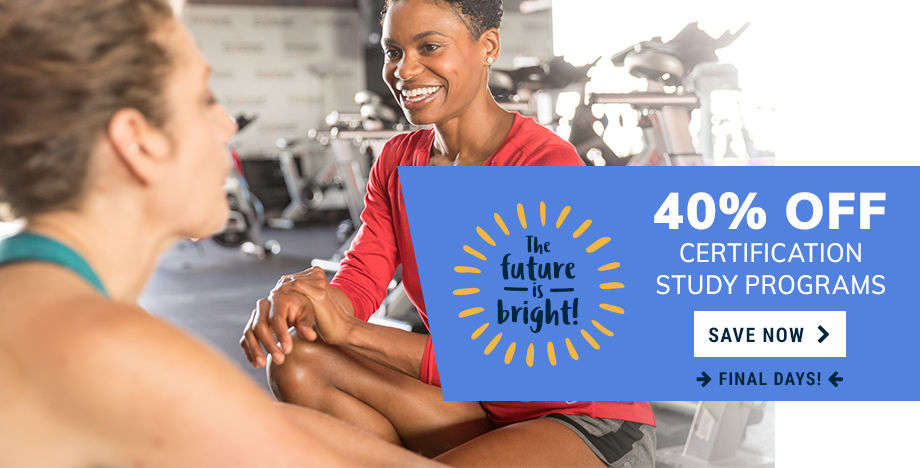Are you tired of spending inordinate amounts of time developing tailored exercise programs only to have a client drop off after a few sessions? You can increase your impact and efficiency by incorporating a few key behavior-change principles into your personal-training program.
Here are five ways to help incorporate behavior-change principles into your daily client interactions.
1. Identify your client’s readiness to change
Noted psychologist James Prochaska is famous for identifying the stages that people typically go through when making a behavior change: precontemplation (not ready), contemplation (maybe one day), preparation (soon), action (now), maintenance (still now, and has been for the past six months or more). Using the “readiness to change ruler” (below) can help you get a sense of your client’s current stage of change. Here’s how:
Ask the client to self-report on a scale of 0 to 10, with 0 being “not considering change now” and 10 being “already changing.” A 0 to 2 response tells you the client is in the early stages of change. The 3 to 7 zone tells you the client is thinking about and maybe even preparing for change. Most clients in the 8 to 10 zone are in the process of changing.
Or, simply ask them to point to where they fall on the “ruler”:
0 1 2 3 4 5 6 7 8 9 10
Not considering change Open to change Already changing
2. Tailor your approach to your client’s readiness to change
Trying to talk someone who is in the contemplation stage of change to set fitness goals is not going to be particularly fruitful or lead to long-term success. You can be most helpful by aligning your fitness interventions with the client’s current stage in the process of change.
For a client in the precontemplative stage of change, ask some open-ended questions to help them increase their awareness about the need for change. For example:
- How will you know when it is time to think about changing?
- What signals will tell you to start thinking about changing?
For a client in the contemplative stage of change, use techniques such as motivational interviewing to help a client work through the ambivalence about change and come to the point where he or she feels ready. For example, try these five open-ended questions recommended by Miller and Rollnick in their book, Motivational Interviewing: Helping People Change (2013):
- Why do you want to make this change?
- How might you go about making this change?
- What are the three best reasons for you to do it?
- How important it is for you to make this change? Why?
Then, reflect back and summarize what you heard the client say before asking:
- What do you think you’ll do?
You can help the client in the preparation stage of change envision what life might look like once he or she has begun the change. Use this process to help develop goals and an action plan to achieve them. It is also a great time to explore potential barriers and identify how to overcome them. For example, you might suggest:
- Identify one or two barriers to making this change now. Together, let’s list some strategies that could help you overcome them.
- Pick the change that is most important to you. Let’s work together to figure out how you can do it by ____________ (fill in a date).
For a client in the action stage of change, spend the time to work with the client to develop a fun and effective exercise program. The goal is to help a client adopt that behavior for six months or more. Here are a few ways to do this:
- What has worked in the past for you? What helped it work? What could help it work even better?
- How can we best keep track of the steps you are making to achieve your goal?
You can help clients in the maintenance stage of change establish routines and accountability to help the positive habits persist despite barriers and obstacles that are bound to show up along the way.
Some questions you might ask include:
- What’s helping you keep to your routine?
- What are your high-risk temptations?
- What else could help you?
Though the stages sound linear, individuals move in and out of the stages frequently, and relapses are common. When clients relapse, explore with them what they learned from the experience that will help them when they start again.
3. See the big picture
While a client may come to you with specific weight-loss or fitness goals, helping him or her to see the big picture and envision what life will be like once the goal is achieved can serve as a powerful source of motivation. One way to do this is through techniques such as creating a vision board. Vision boards can be done in many ways. A common one is to get a poster board and use drawings, collages and collections of words or symbols to represent a vision of the client’s desired future. Other ways include writing a personal mission statement or visualizing what life might look like in five or 10 years if the client makes this change.
4. Implement OARS
An excellent way to improve communication skills and better engage with client is through use of the pneumonic OARS, advocated by Bill Miller and Stephen Rollnick, the founders of motivational interviewing. OARS stands for:
- Open-ended questions. Ask questions that cannot be answered with a “yes” or “no.” Good starts to open-ended questions include: “What…”, “How…,” and “Why…”
- Affirmations. Acknowledge a client’s successes, strengths, abilities and positive efforts.
- Reflective listening. State back to the client what you heard him or her say, and allow the client the opportunity to clarify and/or elaborate.
- Summarizing. Recap two or more ideas or thoughts the client shared, as you understand it.
Practicing and getting really good at OARS is sure to improve listening skills and client communication.
5. Help your client set and monitor short-, medium- and long-term SMART goals
Individuals who are ready to change are well served by Specific, Measurable, Attainable, Relevant and Time-bound goal setting. Engage clients in the process of establishing these SMART goals and guide them to develop very clear aims for getting there.




 by
by 











